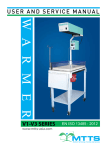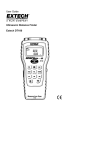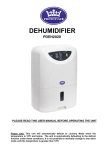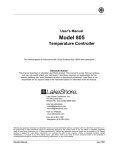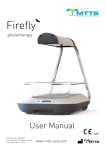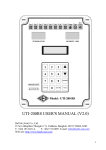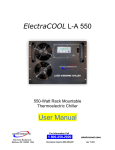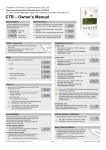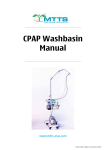Download Heating System
Transcript
W A R M E R V 3.10 - 318 ISO 13485 : 2003 Important information This manual will help you perform preventive maintenance on your MTTS Warmer device. Preventive maintenance should be performed every 6 months and all the information required is enclosed in this manual. Your Warmer came with a tool box which contains all the tools and spare parts for the first session of preventive maintenance. For all further maintenance you will have to order spare parts from MTTS. The tool box includes: Heater element holder Transformer Light bulb Switch for halogen light Halogen light connector and wires Thermal wire insulation If you have any technical problems please call the MTTS hotline at: Tel: + 84 43 766 6521 Fax: + 84 43 766 3844 Email: [email protected] Contact person: Mr. Trần Sỹ Huấn WARMER 3.10 - 3.18 VER1.1 2 General technical information Table of contents Warmer model: 3.10 - 3.18 Important information2 Warranty: 1 year General technical information3 Expected service life: 5 years Table of contents 4 Operating conditions: the warmer has been tested to function properly in 23-30 C. If possible, use the warmer in environments within this temperature range. o Storage conditions: Keep the unit covered with a cloth or plastic cover to prevent it getting dusty or dirty. Store in a dry environment. Class I Medical Electrical Equipment. Warning: to avoid the risk of electric shock, the warmer must only be connected to a supply mains with protective earth. Not classified against ingress of liquids. Assembly5 Introduction9 Warmer System10 Control Unit11 Heating System14 50-60 Hz Temperature Sensor32 180-240V 300W (@180V) – 550W (@240V) Folding Table and Bed33 Warning: Do not modify this equipment without authorization of the manufacturer. Troubleshooting34 Warning: dispose of equipment properly at end of equipment service life. Warmer Test Report35 2 3 WARMER 3.10 - 3.18 VER1.1 3 WARMER 3.10 - 3.18 VER1.1 4 Assembly Step 1: Take the cardboard box apart using a sharp knife or scissors. (Pic.1). Assembly Insert the enclosed pieces of black plastic to ensure a tight fit. (Pic. 5). Take the Warmer out of the box. (Pic.2). Pic. 1 Step 3: Insert the overhead stand into the bed at the available hole. (Pic.3). Step 2: Pic. 2 The 2 holes on the stand and 2 holes on the bed should align. Use one hand to hold the stand and the other hand to insert the screw. (Pic. 4). Pic. 5 Step 4: Assemble the heating system onto the stand. (Pic. 7, 8). Pic. 7 Pic. 3 5 WARMER 3.10 - 3.18 VER1.1 Tighten the screws with a spanner. Make sure washers are used. (Pic. 6). Pic. 6 Pic. 8 Pic. 4 WARMER 3.10 - 3.18 VER1.1 6 Assembly Assembly Ensure the holes of the frame align with the holes of the heating system. (Pic. 9). Pic. 9 Screw 4 screws into the heating system by hand. (Pic. 10). This photo shows the 4 screws temporarily holding the heating system in place. (Pic. 11). Pic. 11 7 WARMER 3.10 - 3.18 VER1.1 Step 5: Connect electric wires This photo shows the lead from the control unit. (Pic. 13). Connect the lead from the control unit to the heating system. Twist the connector clockwise to tighten it into place. (Pic.14). Pic. 10 Pic.13 Using a spanner, tighten all 4 screws. (Pic. 12). Pic. 12 Connect the power cable to the control unit. (Pic. 15). Pic. 15 Pic. 14 Plug the sensor into the front panel. (Pic. 16). Pic. 16 WARMER 3.10 - 3.18 VER1.1 8 Introduction The MTTS WARMER is designed to keep infants warm in first aid emergencies or medical environments that require an appropriate temperature. It monitors the body temperature of the patient and adjusts the heat according to a desired set temperature. Before beginning any technical tasks, DO NOT FORGET to engage the brake on the wheels in order to prevent the Warmer from moving. Turn OFF the Warmer and unplug it from 220V. Warmer System The MTTS Warmer system is composed of: 1 Heating System 2 Control Unit 1. Heating System Sensor 3 4 Folding Table and Bed 2. Control Unit 3. Sensor 4. Folding Table and Bed Pic. 17 9 WARMER 3.10 - 3.18 VER1.1 WARMER 3.10 - 3.18 VER1.1 10 Control Unit Control Unit Sensor Temperature Dial Alarm Speaker Alarm Visual Indicator Alarm Mute Switch This dial sets the desired temperature of the baby/warmer mattress. The possible temperature range is 32 – 38oC in 0.1oC increments. It is set by the user. Turning the dial clockwise increases the temperature setting and counterclockwise dcreas- es the temperature setting. Alarm Speaker Set Temperature Display Set Temperature Knob Sensor Temperature Display Heater Power Display When an alarm condition exists, the speaker will sound. An alarm condition will occur when the temperature of the sensor is higher than the set temperature, or if the sensor cannot make an accurate temperature reading. Horizontal LED display Sensor Connector On/Off Switch Pic. 18 OPERATING PRINCIPLE: The control unit is used to control all the functions of the Warmer. It also provides the user with visual displays describing Warmer operating conditions. This displays the temperature recorded by the skin sensor (the baby’s skin tepera- ture). The sensor has an accuracy of +/- 0.3oC and a range of 19.5-45.8oC. Horizontal LCD display The top line displays the set temperature dialed by the user (32-38oC) and any relevant messages or warnings. The bottom line displays the APGAR clock after the initial warm-up period. APGAR button Front of control unit On/Off Switch Sensor connector Site where the skin temperature sensor is plugged in. Use only MTTS temperature sensors. Turns the power on/off for the whole warmer Alarm system: - - 11 Alarm ‘speaker’: sounds when there is an alarm condition. Alarm button: light flashes when an alarm condition exists. Pressing this button turns the alarm speaker/audible alarm off for 9 minutes. WARMER 3.10 - 3.18 VER1.1 Pressing this button starts the APGAR timer. Alarm indicates after 1 min, 5 min, 10 min, 20 min and 30 min. Back of control unit 220V power inlet Connect grounded power cord from grounded wall outlet to socket. WARMER 3.10 - 3.18 VER1.1 12 Control Unit Heating System Diagnostic buttons Used by MTTS staff during maintenance. Fuses Replaceable safety fuses (5A/250V AC@50A slow blow 5 x 20 mm). 220V heater outlet Light Switch Supplies power to heater element. PREVENTIVE MAINTENANCE: There is no preventive maintenance required for the Control Unit. However, it should be inspected every 6 months by a hospital technician and any failures immediately reported to MTTS. Heater element Halogen Bulb Pic. 19 OPERATING PRINCIPLE: This part of the warmer houses the heater element and a halogen light source. The heater element can provide up to 500W and is regulated by the temperature sensor. The heating system is insulated with fibreglass. A halogen lamp on the warmer provides light for health workers to treat, check and care for the patient. Turn it off after use to conserve the life of the lamp. The halogen lamp is not a light to be used for the treatment of jaundice. A switch on the end of the unit turns the halogen light on and off. PREVENTIVE MAINTENANCE: 1. Replace Halogen Bulb 1.1.Ensure the entire Warmer is turned off by turning the switch off on the Control Unit. 13 WARMER 3.10 - 3.18 VER1.1 WARMER 3.10 - 3.18 VER1.1 14 Heating System Heating System 1.2.Wait for the bulb to cool down. Grasp the halogen bulb using your fingertips and pull. (Pic. 20). 1.3.Insert a new bulb. The polarity of the bulb is not important. Pic. 20 2. Replace Element Holder 2.1. Remove the 4 screws at the end of the Heating System. (Pic. 21). Pic. 24 Pic. 25 2.3. Remove all of the fibreglass insulation within the Heating System. Ensure gloves are worn as the fibreglass particles are highly irritating. (Pic.24, 25). 2.2. Remove the top cover of the Heating System. (Pic. 22, 23). 2.4. Use pliers or a spanner to remove the nuts on the outer threads. Also remove the washers. (Pic.26). Pic. 21 Note the order that the nuts and washers are on the thread. (Pic.27). Nut Nut Washer Lug Washer Nut Nut Pic. 22 15 WARMER 3.10 - 3.18 VER1.1 Pic. 23 Pic.26 Pic. 27 WARMER 3.10 - 3.18 VER1.1 16 Heating System Heating System Pic. 28 2.5.Remove the nuts on the central thread. Note that you may need to hold the inner nut still as shown in pic 28. Also remove the washers and the wire lug. Pic. 30 2.8. Replace all of the nuts, washers and wire lugs in the correct order as shown in Pic. 30. 2.10.Replace the top cover at the heating system. 17 Pic. 29 2.6. Remove the damaged element holder. (Pic. 29). Pic. 32 heater 2.7. Replace the broken heater element holder with a new one. 3. Replace Transformer 3.1.Remove the 4 screws at the end of the Heating System. (Pic. 32). 3.2. Remove the top cover of the Heating System. (Pic. 33, 34). 3.3.Remove all of the fibreglass insulation within the Heating System. Ensure gloves are worn as the fibreglass particles are highly irritating. (Pic. 35, 36). Pic. 34 Pic. 31 2.9. Replace the insulation. Ensure that the insulation does not touch the halogen bulb, and that there is at least 5cm of space around the bulb. (Pic. 31) 2.11.Replace the front plate and 4 screws. Pic. 35 WARMER 3.10 - 3.18 VER1.1 Pic.33 Pic. 36 WARMER 3.10 - 3.18 VER1.1 18 Heating System Heating System 3.4.Unscrew the transformer’s mounting plate from the Heating System Enclosure . (Pic.37, 38). 3.6.2. Pull back the thermal insulation so you can see the heatshrink. (Pic. 42). Use a sharp knife to carefully remove the heatshrink. (Pic. 43, 44). 3.6.3.Use wire - cutters to cut through the solder connections. (Pic. 45). Pic. 37 Pic. 38 3.5.Unscrew the transformer from its mounting plate. You may need to secure the nut on the other side as shown here. (Pic. 39, 40). Pic. 39 Pic. 40 3.6.1.If you follow the thermal insulation away from the transformer towards the halogen light you will notice a gap. (Pic. 41). Pic. 41 WARMER 3.10 - 3.18 VER1.1 Pic. 43 Pic. 42 Pic. 44 3.6.5. The last wire of the transformer is soldered to 2 other wires. Do not remove the heatshrink that is already there and do not cut into the existing connection. For this wire cut it off a few centimetres from the connection away from the heatshrink. 3.6. Disconnect all of the wires from the transformer. 19 3.6.4.Repeat this process for the wire coming from the transformer which is soldered to one other wire. Pic. 45 WARMER 3.10 - 3.18 VER1.1 20 Heating System Heating System 3.7. Remove the old transformer. Make sure you keep the bits of thermal insulation if they are still in good condition. 3.8.Prepare some new heatshrink by cutting it to the right length - about 2cm. (Pic. 46). 3.11. Tin all of the wires. (Pic. 51). 3.12.There are 4 wires coming from the transformer that need to be soldered. Each one requires heatshrink and thermal insulation in the configuration shown below. Make sure to place the heatshrink and insulation before soldering. 3.12.1. 2 wires from the 12V end of the transformer to the halogen bulb. Each of these connections should have heat shrink placed over them. One piece of thermal insulation should be placed over both wires from the transformer to this connection. (Pic. 52). 3.12.2. 1 wire from the 220V end of the transformer connected to one other wire. Place heat shrink and thermal insulation over this connection. 3.12.3. 1 wire from the 220V end of the transformer connected to 2 other wires. (This is the wire that was cut a short distance away from the 3 wire connection). Place heat shrink and thermal insulation over this connection. Pic. 46 3.9.Take your new transformer and strip about 1cm of insulation from the end of each wire. (Pic. 47). 3.10.Clean up all the recently cut wires - cut off wire that has solder on it and strip the insulation. (Pic. 48, 49, 50). Pic. 47 21 WARMER 3.10 - 3.18 VER1.1 Pic. 49 Pic. 50 Pic. 52 3.13. Solder wires: Pic. 48 Pic. 51 3.13.1.2 wires from the 12V end of the transformer to the halogen bulb. Polarity doesn’t matter. (Pic. 53). Pic. 53 WARMER 3.10 - 3.18 VER1.1 22 Heating System Heating System 4. Replace Light Switch 3.13.2. 1 wire from the 220V end of the transformer connected to the single wire. 4.1.Remove the 4 screws at the end of the Heating System. (Pic. 57). 3.13.3. 1 wire from the 220V end of the transformer connected to 2 other wires. 3.14.Slide the heatshrink into the correct position and use a heat gun or a lighter to shrink the heatshrink around the bare metal. (Pic. 54, 55). 3.15.Screw the transformer into its mounting plate. Replace the fibreglass insulation. Ensure gloves are worn as the fibreglass particles are highly irritating. Ensure that the insulation does not touch the halogen bulb, and that there is at least 5cm of space around the bulb. (Pic. 56). 4.2.Use a sharp knife to remove the heatshrink from the old switch. (Pic. 58). Pic. 54 3.16. Screw the transformer’s mounting plate into the Heating System Enclosure. 3.17. Pic. 57 4.3.Desolder the wires going to the old switch. (Pic. 59). Pic. 58 4.4. Remove old switch. (Pic. 60). Pic. 55 3.18.Replace the top cover of the Heating System. 3.19. Replace the cover plate using 4 screws. Pic. 56 23 WARMER 3.10 - 3.18 VER1.1 Pic. 59 4.5.Clean up the recently cut wires cut off wire that has solder on it and strip the insulation. Tin all of the wires. Pic. 60 4.6.Insert a new switch. Make sure the ‘1’ symbol is at the top. WARMER 3.10 - 3.18 VER1.1 24 Heating System Heating System 4.7.Slide heatshrink onto all wires about to be soldered. 4.8.Solder wires to the switch. Make sure you solder to a vertical pair of pins on the switch - the polarity doesn’t matter. 4.9. Slide the heatshrink into the correct position and use a heat gun to shrink the heatshrink around the connection. (Pic. 61). Pic. 61 4.10.Replace the cover plate using 4 screws. 5. Replace burnt wire. Pic. 64 The most common wires that require changing are those that go from the transformer to the light bulb. 5.1.Remove the 4 screws at the of the Heating System. (Pic. 5.2. Remove the top cover of Heating System. (Pic. end 62). Pic. 62 the 63). Pic. 65 5.3.Remove enough fibreglass insulation within the Heating System to give you room to work. Ensure gloves are worn as the fibreglass particles are highly irritating. (Pic. 64, 65). 5.4.Remove the Halogen light bulb. Make sure the bulb doesn’t fall onto a hard surface and break (Pic. 66). 5.5.Use your fingers and a knife to remove the silicon attaching the wires to the mounting bracket. Pic. 66 Screwdriver holding the screw still from the other side 5.6.Remove the screw and nut from the bulb mounting plate by using a screwdriver and something to hold the nut still. (Pic. 67). Pic. 63 25 WARMER 3.10 - 3.18 VER1.1 Pic. 67 WARMER 3.10 - 3.18 VER1.1 26 Heating System Heating System 5.7. Remove the bulb-holder from the mounting plate and cut the wires. (Pic. 68, 69). 5.8. Take a replacement set of wires with bulb-holder (in this case you should have some in your toolbox) and prepare the ends of all wires by stripping the insulation and tinning them. 5.9.Slide thermal insulation heatshrink onto the wires. 5.14.Replace the fibreglass insulation. Ensure gloves are worn as the fibreglass particles are highly irritating. Ensure that the insulation does not touch the halogen bulb. and that there is at least 5cm of space around the bulb. (Pic 71). Pic. 68 6. Replace Heater Element. 6.1. Remove the 4 screws at the end of the Heating System. (Pic. 72). 6.2.Remove the top cover of the Heating System. (Pic. 73, 74). Pic. 69 Pic. 70 27 WARMER 3.10 - 3.18 VER1.1 Pic. 71 5.16.Replace the cover plate using 4 screws. and 5.10.Solder the wires together. Note that polarity isn’t important. (Pic. 70). 5.11.Use a heat gun or lighter to melt the heatshrink around the wires. 5.12.Screw the new bulb-holder back into the mounting plate. 5.13.Place silicon around the back of the bulb holder to stop the wires from moving and to keep the thermal insulation in place. 5.15.Replace the top cover of the Heating System. Pic. 72 Pic. 73 Pic. 74 WARMER 3.10 - 3.18 VER1.1 28 Heating System Heating System Pic. 79 Pic. 75 6.3.Remove all of the fibreglass insulation within the Heating System. Ensure gloves are worn as the fibreglass particles are highly irritating. (Pic. 75, 76). 6.5.Remove the nuts on the central thread. Note that you may need to hold the inner nut still, as shown here. Also remove the washers and the wire lug. (Pic. 79). 6.6.Remove the heater element holder. (Pic. 80). 6.7.Remove the nuts and washers on the other end of the central thread of the heater element. 6.8.Slide out the heater element. (Pic. 81, 82). Pic. 76 6.4.Use pliers or a spanner to remove the nuts on the outer threads. Also remove the washers. (Pic. 77). Note the order that the nuts and washers are on the thread. (Pic. 78). Nut Nut Washer Lug Washer Nut Nut Pic. 77 Pic. 80 Slide the heater element out in this direction Pic. 81 Pic. 78 Pic. 82 29 WARMER 3.10 - 3.18 VER1.1 WARMER 3.10 - 3.18 VER1.1 30 Temperature Sensor Heating System 6.9. To test the heater element, use a multimeter to ensure the resistance from one end to the other is between 95 and 100 ohm. (Pic. 83). Operating Principle: The temperature sensor measures the temperature of whatever it is attached to. Preventive Maintenance: There is no preventive maintenance required for the Temperature Sensor. However, it should be inspected every 6 months by a hospital technician and any failures immediately reported to MTTS. Pic. 83 6.10.Slide a new heater element into the warmer system all the way, then bring it back 5mm so it has room to expand when hot. Also make sure that the heater element is 20mm from the top of the reflector. 6.11.Replace all of the nuts, washers and wire lugs in the correct order as shown here. (Pic. 84). 6.12.Replace the insulation. Ensure that the insulation does not touch the halogen bulb, and that there is at least 5cm of space around the bulb. (Pic.85). 6.13.Replace the front and top plate. Nut Nut Nut Nut Washer Washer Lug Lug Washer Washer Nut Nut Nut Nut Pic. 84 31 WARMER 3.10 - 3.18 VER1.1 Pic. 85 WARMER 3.10 - 3.18 VER1.1 32 Folding Table and Bed Troubleshooting Operating Principle: The heater element never seems to warm up The Bed is used to provide a location for the baby to receive treatment by the Warmer. The folding bed is used as a convenient location to put equipment or miscellaneous items. • • Preventive Maintenance: There is no preventive maintenance required for the folding table and bed. However, every 6 months the folding table should be inspected by raising and lowering the fonding bed to ensure it moves easily and locks into the upright position securely. Check that the side panels of the bed can be moved up and down easily. Any failures should be immediately reported to MTTS. If the set temperature is below the ambient temperature the heater element will not turn on. The warmer is working properly. Ensure the cable from the control unit to the heating system is not damaged and is connected properly. If the problem persists, please call MTTS for service. The displays on the control unit do not illuminate • Ensure the power cable to the control unit is not damaged and is connected properly. The display is showing garbage information • Try resetting the machine by turning the power off and back on again. If the problem persists, please call MTTS for service. The alarms do not stop 33 WARMER 3.10 - 3.18 VER1.1 • If the “Temp too low !” or “Temp too high !” alarms is on, it means that the sensor temperature is out of range from the set temperature. To test this, move the sensor closer/farther from the heater so that it can become with +/- 1o of the set point. If the alarm stops, then the warmer is working properly. If the alarm continues, call MTTS for service. • If the “Sensor failure !” alarm is on, this means that the skinsensor is unplugged or it is broken. Plug the sensor back in if it is unplugged. If the sensor is plugged in and the screen still reads “Sensor failure !”, this means the sensor is broken. Replace the sensor. • If the “Sensor off baby!” alarm is on, this means that the baby sensor is suspected to not be on the baby. Place the sensor on the baby and wait 5 minutes. If the alarm does not turn off automatically, restart the warmer. If problem persists, call MTTS for assistance. • If the “Amb.Sensor fail!” alarm is on, this means that the ambient temperature sensors are not functioning properly. Call MTTS for assistance. WARMER 3.10 - 3.18 VER1.1 34 WARMER MTW 0603/4 VER1.1 Troubleshooting The warmer system is hot to touch • The warmer system is usually warm to touch, however, if it becomes too hot, open the warmer system and check a) that there is enough insulation and b) that it has been placed correctly. • If the problem persists, discontinue use and call MTTS for service. There is smoke or a burning smell coming from the warmer • Immediately turn off the warmer. • Open the warmer system and check to see if any wires look burnt. If so, replace them. Make sure that the insulation is inserted correctly (see instructions). • If the problem persists, discontinue use and call MTTS for service. When any metal on the warmer is touched, one can feel a tingling sensation • This can be caused by inadequate earthing of the warmer. Make sure that the power cable from the wall to the control unit has an earth pin (there should be 3 pins). Try a different 3-pin cable to test if it is damaged. • Ensure the power cable is connected securely. • Some hospitals do not have an adequate earth connection. If you continue to notice a tingling sensation, switch off the warmer immediately, discontinue use, and call MTTS for service. The warmer is uneven on the ground. • There is a hexagonal nut just above each wheel - turn one of these nuts to change the height of the leg. The warmer seems too hot/cold. It is very difficult to determine if the warmer is at the right temperature using your senses. Your perception of temperature can change depending on your health, your mood, ambient environmental conditions, amongst many other things. If you suspect the warmer is not at the right temperature, place a thermometer in the centre of the bed and set the warmer temperature to be 4 degrees above the ambient temperature. If, after 10 minutes, the thermometer is not within 2 degrees of the set temperature then the warmer must be recalibrated. Please call MTTS for this to occur. Note that the warmer can only raise the temperature. If the set temperature is below the ambient temperature, the heating system will not operate. 35 WARMER 3.10 - 3.18 VER1.1 WARMER TEST REPORT HOSPITAL NAME:S/N: DATE: TESTED BY: APPROVED BY: # 1 2 3 TEST: TURN ON THE WARMER LCD display Red 7segment display Alarm test EXPECTED RESULT: Visible blue backlight and clear text 7segment display is clear and correct Short beep during startup; alarm light is on during beep Clear and correct 4 Heater bargraph display LCD display shows correct nr. Hours 5 Press button 1 and clock LCD display shows 4 correct 6 Press button 2 temperatures 1 = babysensor temp; 2,3 = ambient temp; 4 = OFF 7 Turn up/down settemp knob Temperature in 7segment display should go up/down. (Min = 32oC Max = 38.9oC) Bargraph display also changes up/down Halogen light working correct 8 Turn ON/OFF the Halogen light on the top Bed should warm up and LCD display 9 After a few minutes shows correct babysensor temp. Alarm should raise when 10 Alarm test: heat up o babysensor >39oC babysensor to 40 C Turn off warmer for 10m and wait Turn on again Heaterpower =100% (warming up), 11 Look at heaterpower after few minutes heaterpower should decrease Tests 1-11 are OK 12 Settemp = 38oC and temperature of bed Warmer ON at least (babysensor) is close to 38oC 2 hours After 2h repeat tests 1-11 TURN OFF THE WARMER DATE: TESTED: APPROVED: OK FAIL ?? WARMER MTW 0603/4 VER1.1 WARMER TEST REPORT HOSPITAL NAME:S/N: DATE: TESTED BY: APPROVED BY: # 1 2 3 TEST: TURN ON THE WARMER LCD display Red 7segment display Alarm test EXPECTED RESULT: Visible blue backlight and clear text 7segment display is clear and correct Short beep during startup; alarm light is on during beep Clear and correct 4 Heater bargraph display LCD display shows correct nr. Hours 5 Press button 1 and clock LCD display shows 4 correct 6 Press button 2 temperatures 1 = babysensor temp; 2,3 = ambient temp; 4 = OFF 7 Turn up/down settemp knob Temperature in 7segment display should go up/down. (Min = 32oC Max = 38.9oC) Bargraph display also changes up/down Halogen light working correct 8 Turn ON/OFF the Halogen light on the top Bed should warm up and LCD display 9 After a few minutes shows correct babysensor temp. Alarm should raise when 10 Alarm test: heat up o babysensor >39oC babysensor to 40 C Turn off warmer for 10m and wait Turn on again Heaterpower =100% (warming up), 11 Look at heaterpower after few minutes heaterpower should decrease Tests 1-11 are OK 12 Settemp = 38oC and temperature of bed Warmer ON at least (babysensor) is close to 38oC 2 hours After 2h repeat tests 1-11 TURN OFF THE WARMER DATE: TESTED: APPROVED: OK FAIL ?? MEDICAL TECHNOLOGY TRANSFER AND SERVICES No 2 - Lane 70 - Linh Lang, Ba Dinh, Hanoi, Vietnam Tel: + 84 43 766 6521 Fax: + 84 43 766 3844 Email: [email protected] www.mtts-asia.com WARMER 3.10 - 3.18 VER 1.1





















